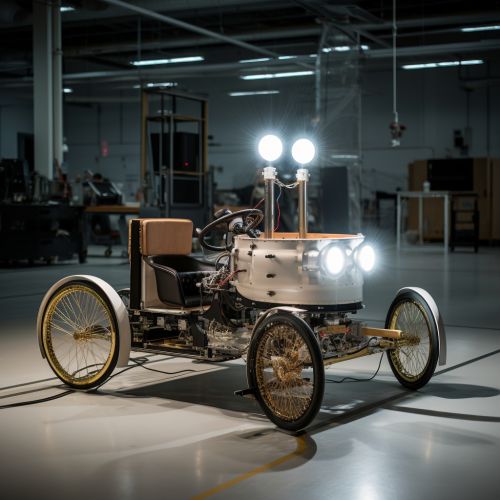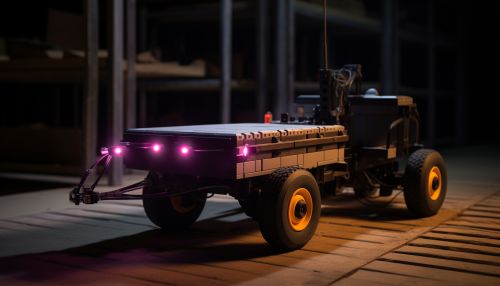Braitenberg vehicles
Overview
A Braitenberg vehicle is a concept used in cybernetics and artificial intelligence to illustrate the principles of sensorimotor coordination. Named after the Italian-Austrian cyberneticist Valentino Braitenberg, these vehicles are simple, hypothetical automata that can exhibit complex behavior based on very simple sensorimotor connections.


Design and Function
Braitenberg vehicles are designed with sensors and motors connected in such a way that they respond directly to stimuli in their environment. The sensors can detect different types of environmental factors, such as light, heat, or sound, and the motors control the movement of the vehicle. The connections between the sensors and motors can be either excitatory or inhibitory, leading to different types of behavior.
The simplest type of Braitenberg vehicle has one sensor and one motor. The sensor detects a stimulus, and the motor responds by moving the vehicle towards or away from the stimulus. This type of vehicle is often used to illustrate the concept of tropism, a biological phenomenon where organisms move towards or away from a stimulus.
More complex Braitenberg vehicles can have multiple sensors and motors, and the connections between them can be arranged in various ways. This allows for a wide range of behaviors, from simple attraction or repulsion to more complex patterns of movement.
Types of Braitenberg Vehicles
Braitenberg described several types of vehicles in his book "Vehicles: Experiments in Synthetic Psychology". Each type of vehicle has a different configuration of sensors and motors, leading to different behaviors.
Type 1: The Aggressive Vehicle
The first type of Braitenberg vehicle, also known as the "aggressive" vehicle, has two sensors and two motors. The sensors are connected to the motors on the same side of the vehicle, and the connections are excitatory. This means that when a sensor detects a stimulus, it causes the motor on the same side to activate. As a result, the vehicle moves towards the stimulus, exhibiting an "aggressive" behavior.
Type 2: The Coward Vehicle
The second type of Braitenberg vehicle, known as the "coward" vehicle, also has two sensors and two motors. However, the sensors are connected to the motors on the opposite side of the vehicle, and the connections are excitatory. This means that when a sensor detects a stimulus, it causes the motor on the opposite side to activate. As a result, the vehicle moves away from the stimulus, exhibiting a "cowardly" behavior.
Type 3: The Explorer Vehicle
The third type of Braitenberg vehicle, the "explorer" vehicle, has two sensors and two motors. The sensors are connected to the motors on the opposite side of the vehicle, but the connections are inhibitory. This means that when a sensor detects a stimulus, it inhibits the motor on the opposite side. As a result, the vehicle moves in a direction perpendicular to the stimulus, exhibiting an "exploratory" behavior.
Type 4: The Lover Vehicle
The fourth type of Braitenberg vehicle, the "lover" vehicle, has two sensors and two motors. The sensors are connected to the motors on the same side of the vehicle, but the connections are inhibitory. This means that when a sensor detects a stimulus, it inhibits the motor on the same side. As a result, the vehicle moves towards the stimulus, but it never reaches it, exhibiting a "loving" behavior.
Applications
Braitenberg vehicles have been used in a variety of applications, from robotics to neuroscience. In robotics, they are often used as a simple model for the development of autonomous robots. By experimenting with different configurations of sensors and motors, researchers can explore different strategies for robot navigation and obstacle avoidance.
In neuroscience, Braitenberg vehicles are used as a model for understanding the principles of sensorimotor coordination. By studying the behavior of these simple vehicles, researchers can gain insights into the complex processes that underlie human and animal movement.
In artificial intelligence, Braitenberg vehicles are used to illustrate the concept of emergent behavior. Despite their simplicity, these vehicles can exhibit complex behaviors that arise from the interactions between their sensors and motors. This has implications for the development of intelligent systems, as it suggests that complex behavior can emerge from simple rules and connections.
